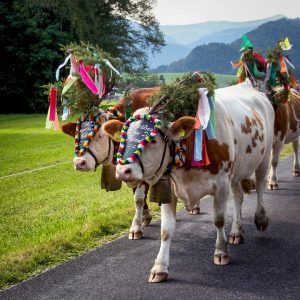
In September and October the cows and bulls are brought down from the lush mountain pastures to the valley and their winter quarters. An event with a long tradition, which is enjoyed by locals and visitors alike. The Viehscheid (and its close partner the Almabtrieb) are part of the same thing, and both are particularly celebrated in the alpine region of the Allgäu. At the beginning of the summer, when the vegetation has really started to grow up in the mountains, cattle are herded up into high alpine pastures, where the herbal grasses are particularly good for their physical condition. Here they’ll be looked after by a cowherd or team of cowherds and their dogs, who’ll continue to do all the daily milking, fence mending etc necessary, and sometimes also offer milk, cheese and other forms of refreshment to passing walkers. This tradition of almost nomadic pastoralism, still very widespread in eastern Europe, involves around 50,000 cows in Germany.
The sound of bells announces the arrival of the herd. Spectators by the side of the path are in for a colorful treat. It’s that time of year again: as the summer draws to a close, the well-fed cattle with their festive decorations come down from the mountain pastures and back into the valley. The whole village joins in the celebrations.Visitors come from far and wide to experience the spectacle. A brass band plays. The convivial beer tents gradually fill up. Regional costume associations showcase their skills at Schuhplatteln dancing and Alphorn blowing. The aroma of Bavarian specialties wafts through the air. Every year during the Almabtrieb, the ceremonial cattle drive which in the Allgäu is also known as the Viehscheid, young and old get to experience anew a piece of Bavarian tradition.
There is always a big party when the cows come home, with a large beer-tent, an orchestra playing, etc. One of the specialities served will be the Hirtenkäse, a distinctive cow’s cheese from the milk of the cows who participated in the Almabtrieb.
